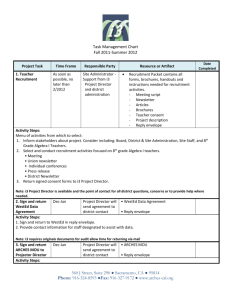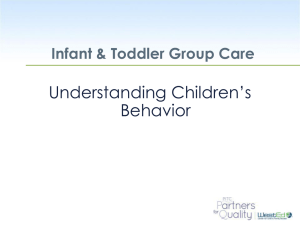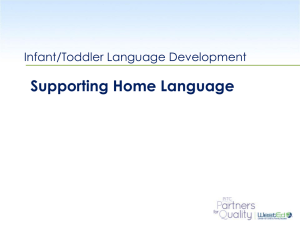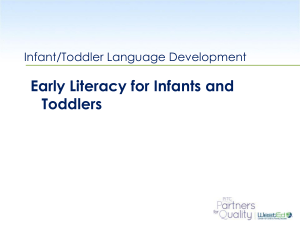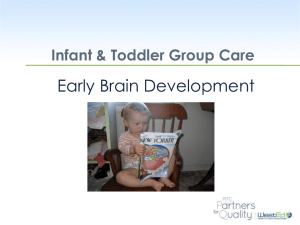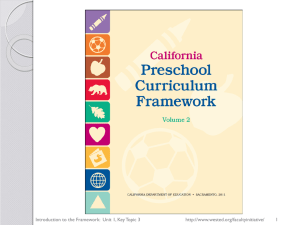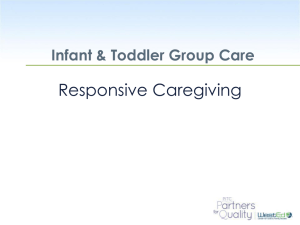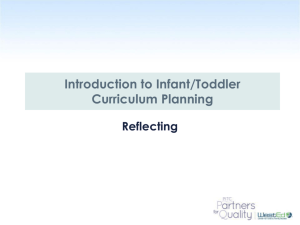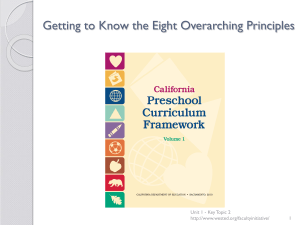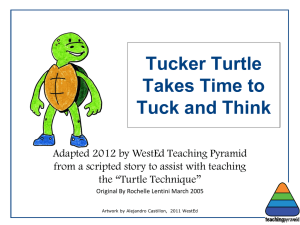English - The Program for Infant/Toddler Care
advertisement
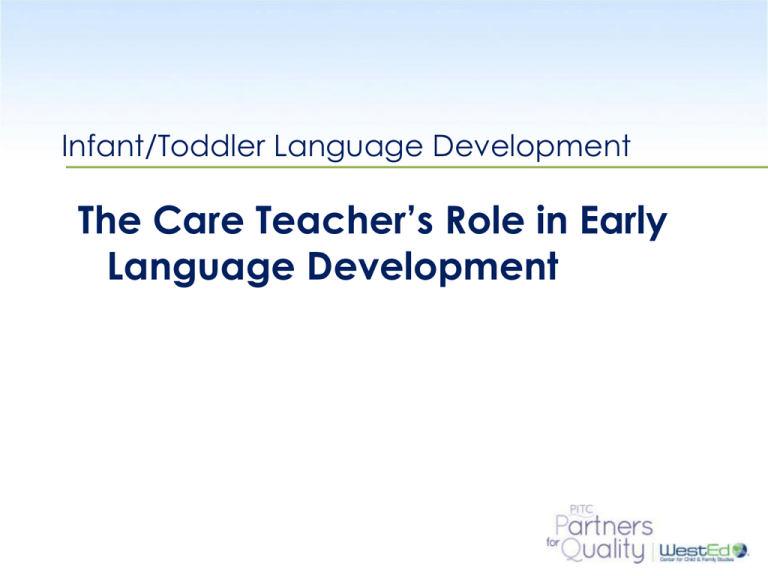
Infant/Toddler Language Development The Care Teacher’s Role in Early Language Development WestEd.org Learning Objectives Participants will be able to: • Explain how enjoyable, responsive and respectful communication exchanges help care teachers support early language development. • Develop strategies to modify her/his behavior and language to fit the needs of each individual child. • Recognize how children differ in their desire and ability to communicate. WestEd.org Conversational Styles • The sociable child: This child initiates constantly and is very responsive to the initiations of other people. • The reluctant child: This child seldom initiates (although she may respond when spoken to) and is often on the outside of interactions and group activities. Adapted from : Teacher Talk Series: Encouraging Language Development in Early Childhood Settings, The Hanen Program WestEd.org Conversational Styles • The child with his own agenda: This child spends a lot of time playing alone, appearing uninterested in interactions with adults and peers. He may initiate when he needs something, but frequently rejects or ignores your efforts to engage him. • The passive child: This child seldom responds or initiates, demonstrating little interest in the objects or people around him. Adapted from : Teacher Talk Series: Encouraging Language Development in Early Childhood Settings, The Hanen Program WestEd.org Individual Reflection Answer the questions on the handout Reflecting on Children’s Conversational Styles. Adapted from : Teacher Talk Series: Encouraging Language Development in Early Childhood Settings, The Hanen Program WestEd.org Discussion Find a partner and discuss what you discovered about yourself, and which children you seem to interact with more. Which types of children do you interact with less frequently? WestEd.org Care Teacher Roles • The Director: This teacher maintains tight control over the children and their activities. She spends much of her time making suggestions, giving directions, and asking questions. • The Entertainer: This teacher is playful and lots of fun, but she does most of the talking. She gives children few opportunities to get actively involved in the interaction. Adapted from : Teacher Talk Series: Encouraging Language Development in Early Childhood Settings, The Hanen Program WestEd.org Care Teacher Roles • The Time Keeper: This teacher rushes through activities and routines in order to stay on schedule. • The Too-Quiet Teacher: This teacher sits with the children, but hardly interacts with them, even when they initiate. Adapted from : Teacher Talk Series: Encouraging Language Development in Early Childhood Settings, The Hanen Program WestEd.org Care Teacher Roles • The Helper: This teacher thinks that children won’t be able to express themselves, so she talks for them or offers help before they show any need for it. • The Cheerleader: This teacher gives the children lots of praise and gets very excited when the children accomplish a task, large or small. She often says the words “Good!”, “Good job!”, “Good sitting!”, “Good Talking!” Adapted from : Teacher Talk Series: Encouraging Language Development in Early Childhood Settings, The Hanen Program WestEd.org Care Teacher Roles • The Responsive Partner: This teacher is tuned in to the children's abilities, needs and interests. She responds with warmth and interest to each child, which encourages the children to take an active part in interactions, both with her and with their peers. Adapted from : Teacher Talk Series: Encouraging Language Development in Early Childhood Settings, The Hanen Program WestEd.org Reflection Take a moment to think about which of the following roles you play when interacting with children: • Which role do you play? • When do you play this role? • What effect does this role have on your interactions or conversations with children? ) Adapted from : Teacher Talk Series: Encouraging Language Development in Early Childhood Settings, The Hanen Program WestEd.org BREAK WestEd.org Help Children Expand Language Reflect on what you see the care teachers doing to expand language. Early Messages DVD: Strategy 5: Helping Children Expand Language WestEd.org Help Children Expand Language • What are some examples of descriptive language you use? • Do you use openended questions when talking with children? Give an example. WestEd.org Using Books to Expand Language • Young infants may be interested in books, but it may take a while for them to understand that books have a purpose and are used in a certain way. • Mobile infants start to use words and realize that pictures in books represent real people and objects. • Older infants have more vocabulary. They begin to combine words and take more turns in conversations. Their receptive language has also increased, and they can enjoy a wider variety of books. WestEd.org Sharing Ideas For the two books you brought to share, do the following: On a 5 x 7 card write the title of the book and author, along with a brief statement why you believe this is an appropriate book to use with infants and toddlers. After you’re done, place the 5 x 7 cards next to your books. WestEd.org Summary • The responsive care teacher modifies her/his behavior and language to fit the needs of each individual child. • Children have different conversational styles. Care teachers want to ensure that they respond to all children, not just sociable children. •Care teachers use books to expand children’s language. WestEd.org
